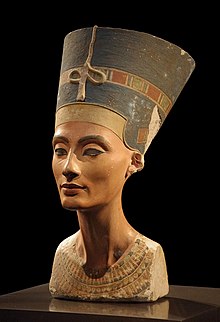
Back Borsbeeld van Nefertiti Afrikaans تمثال نفرتيتي Arabic تمثال نفرتيتى ARZ Nefertitinin büstü Azerbaijani Бюст Неферціці Byelorussian Бюст Нэфэртыці BE-X-OLD Bust de Nefertiti Catalan Busta královny Nefertiti Czech Büste der Nofretete German Busto de Nefertiti Spanish
| Nefertiti Bust | |
|---|---|
 The iconic bust of Nefertiti is part of the Egyptian Museum of Berlin collection. | |
| Material | Limestone and stucco |
| Height | 48 centimetres (19 in) |
| Weight | 20 kilograms (44 lb) |
| Created | 1345 BC Thutmose, Ancient Egypt |
| Discovered | 6 December 1912 Amarna, Egypt |
| Discovered by | German Oriental Society |
| Present location | Neues Museum Berlin, Germany |
| Identification | ÄM 21300 |
 3D model (click to interact) | |
The Nefertiti Bust is a painted stucco-coated limestone bust of Nefertiti, the Great Royal Wife of Egyptian pharaoh Akhenaten.[1] It is on display in the Egyptian Museum of Berlin.
The work is believed to have been crafted in 1345 BC by Thutmose because it was found in his workshop in Tell-el Amarna, Egypt.[2] It is one of the most-copied works of ancient Egypt. Nefertiti has become one of the most famous women of the ancient world and an icon of feminine beauty.[3]
A German archaeological team led by Ludwig Borchardt discovered the bust in 1912 in Thutmose's workshop.[4] It has been kept at various locations in Germany since its discovery, including the cellar of a bank, a salt-mine in Merkers-Kieselbach, the Dahlem museum, the Egyptian Museum in Charlottenburg and the Altes Museum.[4] It is displayed at the Neues Museum in Berlin, where it was originally displayed before World War II.[4] Egypt has called for the return of the bust, citing provisions that prohibited any items of great archaeological value from leaving Egypt. Egypt accuses Borchardt of "wrapping the bust to conceal its value and smuggling it out of the country".[5]
The Nefertiti bust has become not only a defining emblem of ancient Egypt, but also a symbol of the impact that European colonialism has had on Egypt's history and culture. It has been the subject of an argument between Egypt and Germany over Egyptian demands for its repatriation, which began in 1924, once the bust was first displayed to the public, and more generally it fuelled discussions over the role museums play in undoing colonialism.[6] Today, Egypt continues to demand the repatriation of the bust, whereas German officials and the Berlin Museum assert their ownership by citing an official protocol, signed by the German excavators and the French-led Egyptian Antiquities Service of the time.
- ^ "Nefertiti – Ancient History". History.com. Retrieved 18 November 2016.
- ^ e.V., Verein zur Förderung des Ägyptischen Museums und Papyrussammlung Berlin. "Nefertiti: (Society for the Promotion of the Egyptian Museum Berlin)". www.egyptian-museum-berlin.com. Retrieved 18 November 2016.
- ^ Conrad, Sebastian (2024). "The Making of a Global Icon: Nefertiti's Twentieth-Century Career". Global Intellectual History: 1–32. doi:10.1080/23801883.2024.2303074. ISSN 2380-1883.
- ^ a b c Tharoor, Ishaan. "The Bust of Nefertiti: Remembering Ancient Egypt's Famous Queen". Time. ISSN 0040-781X. Retrieved 18 November 2016.
- ^ "Egypt renews demands to retrieve Nefertiti bust from Germany - Al-Monitor: Independent, trusted coverage of the Middle East". www.al-monitor.com. October 2020. Retrieved 15 April 2023.
- ^ Diamond, Kelly-Anne (6 April 2019). "DO MUSEUMS PLAY A ROLE IN UNDOING COLONIALISM?". Hindsights. Retrieved 15 April 2023.